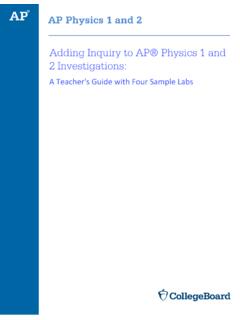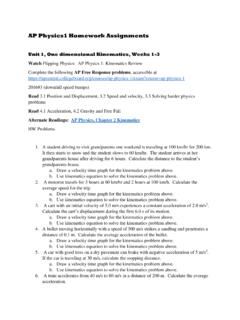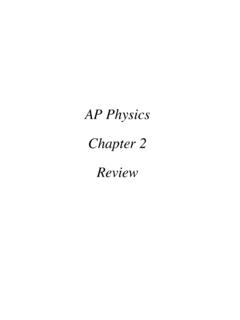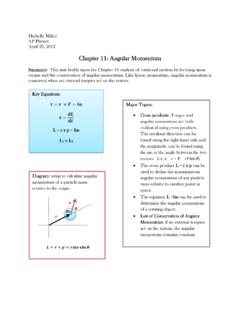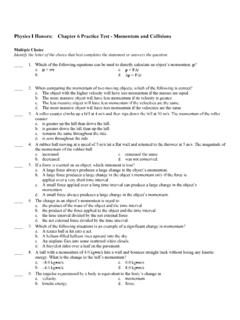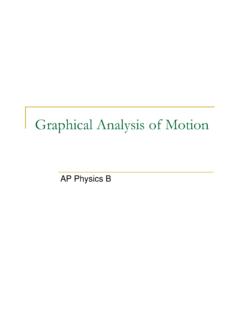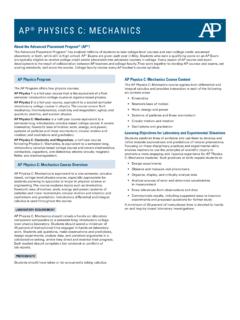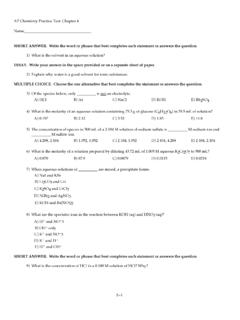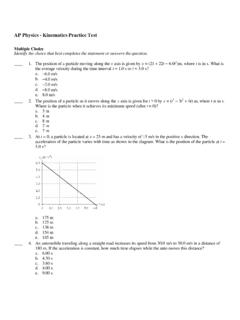Transcription of Chapter 4: Force and Motion - Astronomy & Physics
1 SMU PHYS1100, fall 2008, Prof. Clarke1 Chapter 4: Force and MotionWe are skipping: Chapter 3: Vectors and Coordinate SystemsStudents are nevertheless responsible for its contents (grade 11 math) and to be able to do the type of problems in its end-of- Chapter (EOC) problem go directly to Chapter 4, an introduction to is the branch of Physics that seeks the reasonsfor Motion : + dynamics = mechanicsSMU PHYS1100, fall 2008, Prof. Clarke2 Chapter 4: Force and MotionDefinition: A Force is a push or a pull on an object, is a vector quantity (both direction and magnitude), and requires an agent (something that does the pushing or pulling).A Force can either be a contact Force ( , normal Force , string tension, etc.) or a long-range Force ( , gravity, electrical forces, etc.)
2 , known in antiquity as an action at a distance).This semester, the only long range Force we ll use is gravity. All other forces will be contact PHYS1100, fall 2008, Prof. Clarke3 Chapter 4: Force and MotionRepresenting forces as vectors:Whether a Force is: a contact Force or long-range; pushing on the object or pulling,always represent a Force as a vector with: its tail anchored to the object being forced; its tip pointing in the direction of the Force ; labels for both the Force and the PHYS1100, fall 2008, Prof. Clarke4 Chapter 4: Force and MotionAdding forces as vectorsIf F1 = (3, 4) N and F2= (0, 5) NFnet= (3+0, 4 5) = (3, 1) N Forces are measured in Newtons(N)(we ll come back to this) Force components:xy FFx= Fcos( )Fy= Fsin( )SMU PHYS1100, fall 2008, Prof.
3 Clarke5 Chapter 4: Force and Force Catalogue 1. Weightis the Force of gravity acting downward. It is a long-range Force , and its agent is the mg= mg y2. A spring forceacts in a direction opposite to the distortion ( x) of the spring (compressed or stretched). It is a contact k xSMU PHYS1100, fall 2008, Prof. Clarke6 Chapter 4: Force and Motion3. Tension(in a rope or wire) always acts in the direction of the rope. It is a contact Force and represented by: T4. A normal forceis exerted by a surface on an object pressing against that surface. It is a contact Force , always acts perpendicular(normal) to the surface, and is represented by: nnndoes notalways equal mg!!!SMU PHYS1100, fall 2008, Prof. Clarke7 Chapter 4: Force and Motion5. Resistive forces(all contact)a) static friction, fs< sn, prevents Motion along a surface and points in the direction opposite to the Motion it ) kinetic friction, fk= kn, resists Motion along a surface, and points in the direction opposite to the ) dragis kinetic friction caused by Motion through bAv2velocity frog would have if there were no fsSMU PHYS1100, fall 2008, Prof.
4 Clarke8 Chapter 4: Force and Motion6. Other forces thrust: Fthrust(contact) electrical Force : FE= qE(long-range) magnetic Force : FM= qvxB (long-range)SMU PHYS1100, fall 2008, Prof. Clarke9 Chapter 4: Force and MotionSummary of forcesm=gravitationalmassg= m s 2k =spring constant (N m 1) x=displacement s=coefficient of static friction (unitless) k=coefficient of kinetic friction (unitless)< sA=cross-sectional areab= kg m 2for airgravityw=mgearthlong-rangespring forceFsp= k xspringcontactTension forceTrope, wirecontactnormal forcensurfacecontactstatic frictionfs< snsurfacecontactkinetic frictionfk= knsurfacecontactair dragD=bAv2aircontactThrustFthrusthot gascontact}direction opposes motionnameformulaagenttypeSMU PHYS1100, fall 2008, Prof. Clarke10 Chapter 4: Force and MotionPre-Newtonian/Galilean mechanics: Motion according to AristotleThe natural state of all objects is to be at rest.
5 To keep things moving, one must always apply a Force . Thus, once the horse stops pulling the cart, the cart comes to PHYS1100, fall 2008, Prof. Clarke11 Chapter 4: Force and MotionPre-Newtonian/Galilean mechanics: Motion according to AristotleThe natural state of all objects is to be at rest. To keep things moving, one must always apply a Force . Thus, once the horse stops pulling the cart, the cart comes to me, Mr. Aristotle, but then what keeps the arrow moving once it s been launched from the bow?SMU PHYS1100, fall 2008, Prof. Clarke12 Chapter 4: Force and MotionFThe natural state of all objects is to be at rest. To keep things moving, one must always apply a Force . Thus, once the horse stops pulling the cart, the cart comes to me, Mr. Aristotle, but then what keeps the arrow moving once it s been launched from the bow?
6 Pre-Newtonian/Galilean mechanics: Motion according to AristotleSMU PHYS1100, fall 2008, Prof. Clarke13 Chapter 4: Force and MotionI then what about this? If I let go of a stone---I don t even need to give it a push---it gathers speed all on its own accord. If rest is the stone s natural state, why does it start moving from rest?SMU PHYS1100, fall 2008, Prof. Clarke14 Chapter 4: Force and MotionI then what about this? If I let go of a stone---I don t even need to give it a push---it gathers speed all on its own accord. If rest is the stone s natural state, why does it start moving from rest?Earth, water, wind and fire---elements seek out their own kind. Solid rock seeks out solid PHYS1100, fall 2008, Prof. Clarke15 Chapter 4: Force and MotionI then what about this?
7 If I let go of a stone---I don t even need to give it a push---it gathers speed all on its own accord. If rest is the stone s natural state, why does it start moving from rest?Earth, water, wind and fire---elements seek out their own kind. Solid rock seeks out solid , why does the fire in my firepit not jump over to join the fire in yours?Why does a stick float and not join the solid bottom?Why, why, why?SMU PHYS1100, fall 2008, Prof. Clarke16 Chapter 4: Force and MotionI then what about this? If I let go of a stone---I don t even need to give it a push---it gathers speed all on its own accord. If rest is the stone s natural state, why does it start moving from rest?Earth, water, wind and fire---elements seek out their own kind. Solid rock seeks out solid , why does the fire in my firepit not jump over to join the fire in yours?
8 Why does a stick float and not join the solid bottom?Why, why, why?Go home, PHYS1100, fall 2008, Prof. Clarke17 Chapter 4: Force and MotionThe three laws of Sir Isaac Newton (1687)1. A body s velocity will not change if and only if there is no net Force acting on The net Force on a body is equal to the product of the body s mass and acceleration: F= Fnet= When two bodies interact, the forces exerted by each body on the other are always equal in magnitude and opposite in greatness is measured by the magnitude and scope of impact on humanity, these are among the greatest utterances ever uttered by a PHYS1100, fall 2008, Prof. Clarke18 Chapter 4: Force and MotionOther versions you may have heard 1. Law of Inertia: A body at rest tends to stay at rest and a body in Motion tends to stay in Motion unless acted upon by a netexternal F = maand you can t push on a rope (the first-year engineer s dictum).
9 3. For every action, there is an equal and opposite PHYS1100, fall 2008, Prof. Clarke19 Chapter 4: Force and MotionOr, we could just go with what Newton himself I. Corpus omne perseverare in statu suo quiescendi vel movendi uniformiterin directum, nisi qua tenus a viribus impressis cogitur statum illum II. Mutationem motus proportionalem esse vi motriciimpressae, et fierisecundu`m lineam rectam qu a vis illa III. Actioni contrariam semper et aequalem esse reactionem: sive corporumduorum actiones in se mutuo semper esse aequales et in partes contrarias dirigi.(see the websitefor a widely-accepted translation)Other versions you may have heard 1. Law of Inertia: A body at rest tends to stay at rest and a body in Motion tends to stay in Motion unless acted upon by a netexternal F = maand you can t push on a rope (the first-year-engineer s dictum).
10 3. For every action, there is an equal and opposite PHYS1100, fall 2008, Prof. Clarke20 Chapter 4: Force and MotionQuotations from/about Sir I have seen farther, it is by standing upon the shoulders of giants.(in a letter to Robert Hooke, another well-known natural philosopher of the day, who was a diminutive man with a hunchback and for whom Newton held considerable disdain.)I do not know what I may appear to the world, but to myself I seem to have been only like a boy playing on the sea-shore, and diverting myself in now and then finding a smoother pebble or a prettier shell than ordinary, whilst the great ocean of truth lay all undiscovered before the absence of any other proof, the thumb alone would convince me of God's epitaph: Who, by vigor of mind almost divine, the motions and figures of the planets, the paths of comets, and the tides of the seas first and nature's laws lay hid in night; God said "Let Newton be" and all was light.

